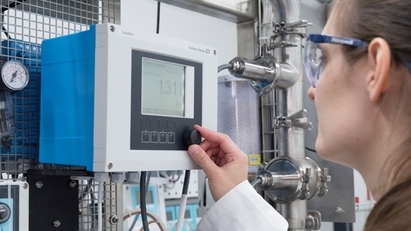About process photometers
Process photometers for UV absorption, NIR and VIS provide precise and compliant inline concentration, color and turbidity measurement. Thanks to their hygienic design, they are ideally suited for chromatography, fermentation, filtration, phase separation and crystallization. Their high temperature and pressure stability also ensure safe application in condensate monitoring or leak detection of heat exchangers. To check out our broad portfolio of process photometers, click the button below.
How to select process photometers
Our process photometers are used in many industries such as life sciences, pharmaceuticals, food & beverage, chemical and oil & gas. The selection of the sensor depends on the application. Choose the optical sensor's wavelength according to your needs. For example, NIR absorbance for cell growth measurement or dual wavelength for color measurement. Select turbidity sensors using the scattered light method for filter control and make sure to apply approved process photometers in hazardous areas.
Absorbance measurement
Absorbance measurement is based on the interaction of introduced light with the medium according to the Lambert-Beer law. A light source emits radiation through the medium and the transmitted radiation is measured on the detector side. After passing a filter for wavelength detection, the intensity of light is determined by a photodiode and converted into a photoelectric current.
The light intensity received is proportional to the concentration of the substances under measurement. The final conversion to absorption units (AU) or optical density (OD) is done by the transmitter.
Absorbance = measurement of the attenuation of light relative to the introduced light
Turbidity measurement with the scattered light method
In turbidity measurement, a light source introduces a focused beam into the medium. This beam is deflected by particles in the medium, causing it to scatter. The scattered light is measured by receivers and the turbidity is determined. Forward scatter measurement at 11° is a suitable method when turbidity is low. Smaller particles produce a low and larger particles a high scatter intensity. Filter breaks are detected immediately, making this an excellent method for monitoring filtration.
Benefits
- Inline measurement with our process photometers for UV absorption, NIR, VIS and turbidity replaces time spent sampling and measuring in a lab and prevents product contamination.
- Our process photometers can easily be combined with pH, conductivity or oxygen sensors using only one Liquiline CM44P transmitter. They make perfect application packages for process quality monitoring.
- Thanks to their simple, optical measuring principle, our spectrophotometers work without reagents and provide low cross-sensitivity to other parameters.
- We offer NIST-traceable, certified calibration filters that replace complex liquid calibration with standards and reduce the maintenance.
- Low-volume flow cells for the process photometers enable fast measurement and ensure optimum product yield.


















